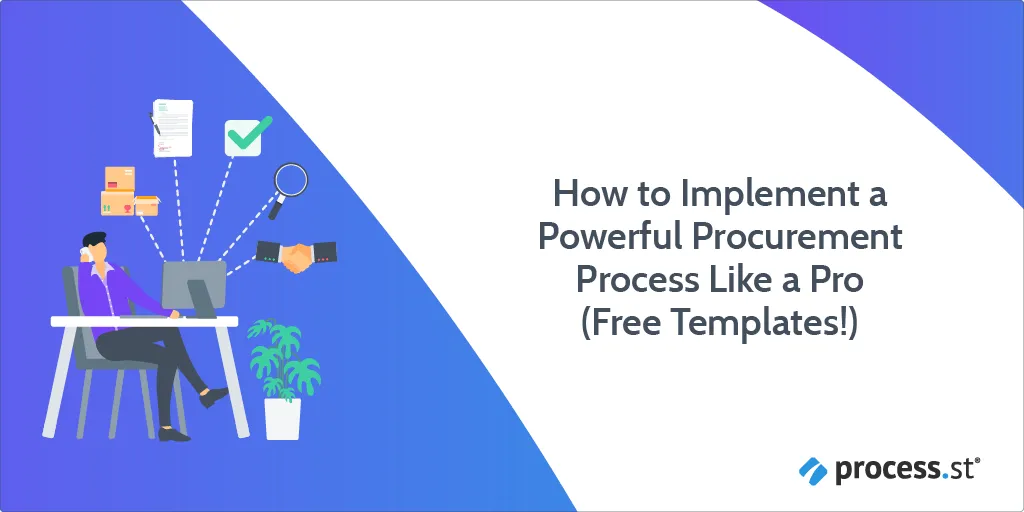How to Implement a Powerful Procurement Process Like a Pro (Free Templates!)
Blog: The Process Street Blog

If there’s one thing the COVID-19 pandemic has taught the world of business (apart from that remote work is the future), it’s this: We aren’t prepared for disruption.
Supply chains, in particular, suffered a massive shockwave, with supermarkets, shops, and services being unable to operate the way they did before the virus struck. In fact, more than 3,000 suppliers in China were driven to force majeure declarations in the first few months alone.
As the world moves toward a new normal, you’ll be thinking about disruption and risk a lot more than you had done previously.
For businesses using suppliers, it’s necessary – now more so than ever – to establish a stellar procurement process to ensure goods and/or services can always be secured, no matter if micro (small, every day) and macro (large, extraordinary) disruptions happen.
That’s why, in this post, I’ll be discussing what the procurement process is, the benefits a documented and solid process brings, what the flow of a robust procurement process looks like, and how Process Street can help.
Read through the below sections to get up-to-date:
- What is procurement and the procurement process?
- The benefits of the procurement process
- The procurement process flow (with a procurement process example)
- Use Process Street for procurement and all other business needs!
Or, if you just wanted to get your hands on a procurement process that you can default to in every day and extraordinary situations alike, grab it here:
Click here to get the Procurement Process Checklist Template!
Ready to become a pro at the procurement process? 
What is procurement and the procurement process?
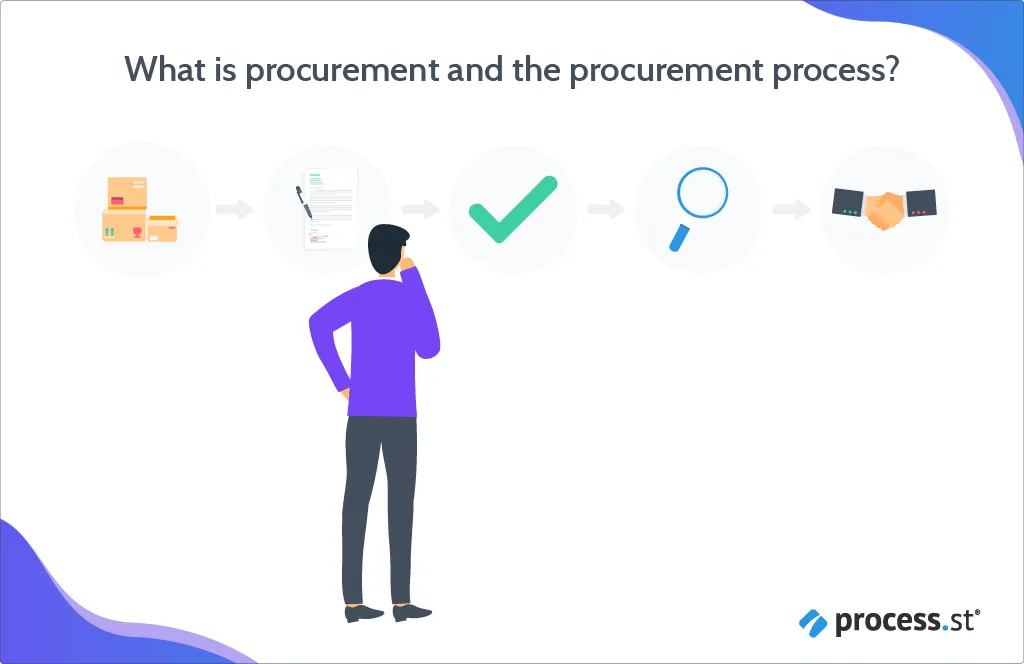
The purpose of procurement is to ensure that a company buys the goods and/or services it needs to operate profitably.
To do this, many tasks need to be undertaken so that goods or services are bought for a sensible price, while maintaining standards of quantity, quality, and reasonable delivery time. Depending on a company’s size and the sector it’s operating in, some will employ individuals whose sole purpose is to oversee procurement. If large enough, there could be a whole procurement team devoted to it.
What’s also important to note is the difference between purchasing and procurement.
Procurement isn’t purely to do with transaction, i.e. paying a supplier money in return for goods. Procurement, instead, goes beyond that and is all-encompassing. So much so, there are often multiple people working across various teams to complete the following steps:
- Identifying what goods or services the business needs.

- Getting purchase requests approved internally.

- Finding suitable external suppliers.

- Engaging in tendering or competitive bidding processes.

- Negotiating with suppliers and drawing up contracts.

- Acquiring, receiving, and inspecting the goods.

- Developing and furthering business relationships with suitable suppliers.

As the team at Supply Chain Game Changer expertly put it:
“In short: Purchasing is an activity that’s a subset of the overall procurement process.” – Supply Chain Game Changer, What’s the Difference between Procurement and Purchasing?
What is the procurement process?
To put it simply, the procurement process is made up of all the steps and tasks that need to be completed so that procurement can be done successfully.
Without having a standard process for procurement, the flow for how it’s done can be different every time, which isn’t exactly, well, good (and especially when times aren’t ‘normal’). The absence of a procurement process means you could continually go about procurement poorly, thereby increasing your bottom-line rather than reducing it.
Suffice to say, having a procurement process is incredibly important.
The benefits of the procurement process

At its core, the procurement process is about saving costs. In fact, recent studies show that 54% of professionals recognize cost-saving as the procurement process’ main area of focus.
Those at the helm of procurement are constantly asking themselves questions such as: Who are the most affordable suppliers? How can we get the goods transported to us as cheaply and as quickly as possible? What ways can we develop our relationships with the suppliers we’re working with for financial benefit? And, with a procurement process, costs will be saved, particularly when operating under conditions of scarcity.
There are many, many more advantages that come from having a procurement process, too.
Specifically, it:
- Establishes a method for going about procurement.

- Halts the normalization of deviancy.

- Reduces human error.

- Saves time.

- Easier to overcome disruptions.

A process is a series of actions and tasks that must be undertaken to complete a goal or objective. By having a procurement process that’s tailored to your business’ size, sector, location, and all its many other needs, you’re establishing a method for what to do, when, how, and why. Having a procurement process, then, is useful for you, your teammates, and any new hires who are being onboarded and need to get to grips with their role, stat.
In the workplace – be it at the office or the warehouse – employees start off completing their tasks (and thereby processes) exactly how their managers would want them to. But, after a while – and perhaps after seeing colleagues acting in similar ways – deviancy creeps in and corners are cut. But by having a procurement process, there’s an expectation of what employees should and must do.
Considering the nature of the procurement process – working with sizeable sums of money, getting crucial items approved, collaborating directly with suppliers – the last thing you want to do is mess up a goods order, your relationship with a supplier, or create a downright abysmal contract by missing an important step or task. With a procurement process, human errors, mistakes, and accidents can be reduced. Always.
If this is the first time you’re reading about the procurement process, you may be thinking something along the lines of “While it does look beneficial, the procurement process sounds lengthy and my day is jam-packed as it is!” The good news is that a procurement process actually saves you time, rather than making procurement longer. That’s because there’ll be less to-ing and fro-ing, fewer mistakes made, and you’ll be able to get procurement tasks completed quicker and be more productive, too.
Remember at the beginning of the article when I discussed every day and extraordinary disruptions? By having a procurement process, you’re able to respond to disruptions more appropriately, rather than acting like a chicken that’s lost its head. Speaking of chicken and disruptions due to not going about procurement properly, read Amanda Greenwood’s post Digital Procurement: How to Cut Costs Without Losing Profitability! (Just don’t read it on an empty stomach…)
An impressive list of benefits, right?
If you and your business don’t already have a procurement process in place and you’re going about it all in a willy-nilly manner, it’s high time you created a procurement process and documented it with state-of-the-art BPM software. It’ll allow you to make a thriving business.
The importance of documenting your procurement process
What is BPM, exactly?
It stands for business process management, and using BPM software is a must for businesses who both literally and figuratively can’t afford to go about its processes the wrong way (46% of companies see BPM as a way of reducing business costs, in fact).
To make sure you and your team do go about them the right way, you’ll first need to document your processes with BPM software.
That’s because it isn’t enough to rely on memory. Nor is writing a process on a piece of paper enough, as paper is prone to being shoved in drawers and never again seeing the light of day.
Similarly, documenting business processes via Word or Excel isn’t helpful either, as they don’t cover the scope that dedicated BPM software can.
Process Street in particular makes process documentation incredibly easy. All you need to do to get started is sign up for a free trial and document your processes as templates!
Check out the introductory video to get acquainted.
To make getting started with Process Street even easier for you, I’ve got a ready-made Procurement Process Checklist Template for you to make use of. I’ll also, in the upcoming section, demonstrate how to use it to its full potential. 
The procurement process flow (with a procurement process example)

If you haven’t added the Procurement Process Checklist Template to your account yet, add it now.
Click here to get the Procurement Process Checklist Template!
In terms of flow, it starts with you – the person who’s in charge or at least predominantly involved with your business’ procurement – adding basic details about your organization.
Shortly after, you’re required to properly identify the goods and/or services to procure.
To do this, you’ll:
- Establish what the business needs (where you’ll make use of the Business Needs Assessment Template)
- Confirm which business need you’re procuring for (the flow concerns one business need at a time, so you’ll need to launch a new checklist for each business need)
- Establish what goods and/or services are needed (so you can choose the goods and/or services your business needs the most).

Once those tasks are complete, you’ll move onto the first approval stage.
It’s here that you’ll be prompted to:
- Send a purchase request to your purchasing/finance team
- Get the purchasing/finance team to approve the purchase request via Process Street’s nifty approvals feature (or reject it if they feel the need to)
- Upload the purchase order (PO) once it has been approved.
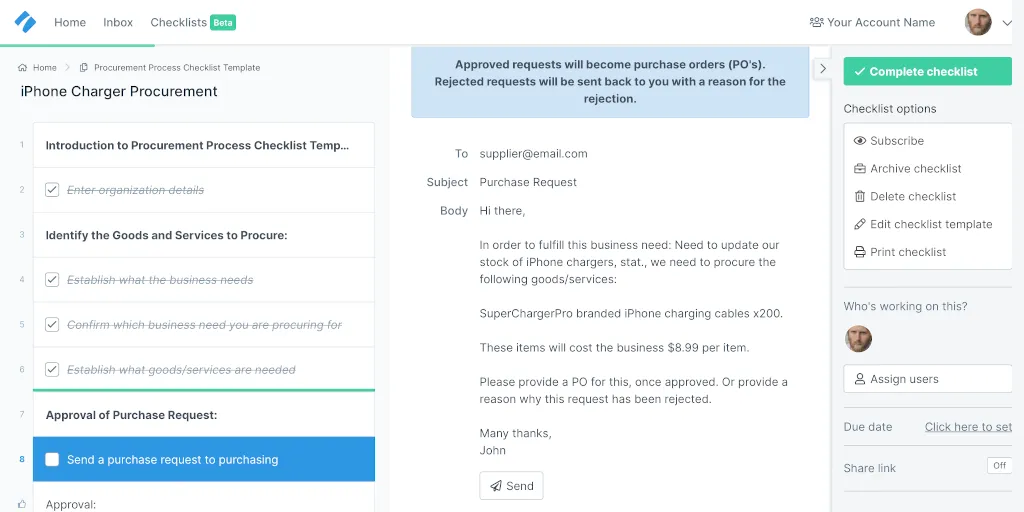
This section won’t take long at all, and having the purchasing/finance team’s go-ahead will help to ensure that you’re on the right track with whatever it is you’re procuring. It’s also in line with best practices for procurement, which Julie Young at Investopedia outlines here:
“In many cases, procurement processes will be dictated by company standards often centralized by controls from the accounts payable division of accounting. The procurement process includes the preparation and processing of a demand as well as the end receipt and approval of payment.” – Julie Young, How Procurement Works
Then, it’s time to get to the nitty-gritty and start compiling a list of suitable suppliers. Although all steps within this procurement process are important, it’s the tasks in this section that you’ll have to complete diligently. Otherwise, you could lock yourself into a contract with a supplier that you’d rather not be working with.
Once you’ve got together a list of potential, seemingly suitable suppliers, you’ll want to send a request for quotation (RFQ) to them. Sending an RFQ marks the beginning of contact with a supplier you haven’t used before, as you’ll be providing them with information about your order and what you need, and they’ll be coming back with a proposal that outlines their capabilities and the associated costs.
An appropriate RFQ consists of:
- The number of goods and/or services you need
- The quality of the goods and/or services that you expect
- The location of where you want the goods and/or services delivered to
- When you want the goods and/or services delivered to you and how frequently
- The delivery method(s) you want for the goods and/or services.
After a little time has passed and you’ve received quotations from the suppliers you’ve reached out to, you’ll whittle them all down to a shortlist of 3. Then, you’ll do some in-depth research on the 3 suppliers, specifically looking at their:
- Logistic capabilities
- Distribution models
- Experience
- Company size
- Customer reviews
- Overall price
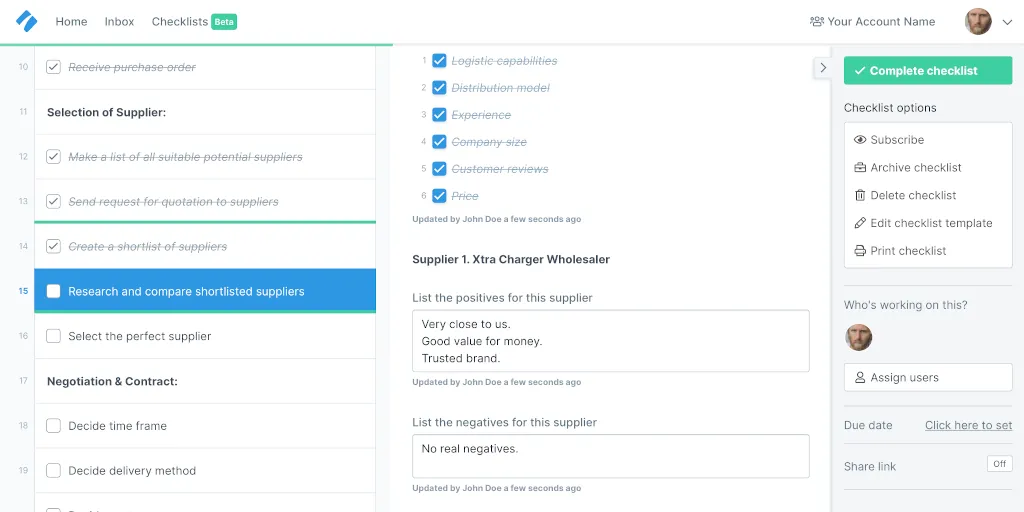
By conducting this research, you’ll then be able to whittle the shortlist further down to one supplier you’ll want to use for the goods and/or services in question. This, then, takes you onto the next section of tasks: “Negotiation & Contract”.
For drawing up the contract, you’ll be asked to:
- Decide on a timeframe for when you want the goods and/or services delivered
- Decide the delivery method(s) for the goods and/or services
- Decide on overall costs and what you’re willing to pay
- Write the contract document
- Get the contract internally approved
When the contract has been approved, you’ll then:
- Send the contract to the supplier (where they’ll hopefully sign it straight away)
- Sign the contract yourself, once the supplier has signed it
- Send the purchase order to the supplier
With all these tasks tackled, you’re nearly done!
When the goods and/or services arrive, though, you’ll have a set of tasks to essentially make sure everything looks like it’s in working order. If it isn’t, you’ll note down what the issues are and contact the supplier regarding the problems. If all looks OK, you’ll upload the supplier’s invoice and move onto three-way matching, which is basically triple-checking the PO, receipt, and supplier invoice to make sure it all adds up.

Before the process finally wraps up, there’s just a bit of housekeeping to do.
Firstly, you’ll need to approve the supplier invoice with Process Street’s approval function, and then send the invoice to the accounts team for processing. This is easily done with the email widget.
Secondly, you’ll need to upload the purchase order, receipt, invoice, supplier information, and the contract to a central location. Doing so will give your team – and business-at-large – complete transparency regarding the procurement. Plus, it’s handy to back everything up elsewhere, too.
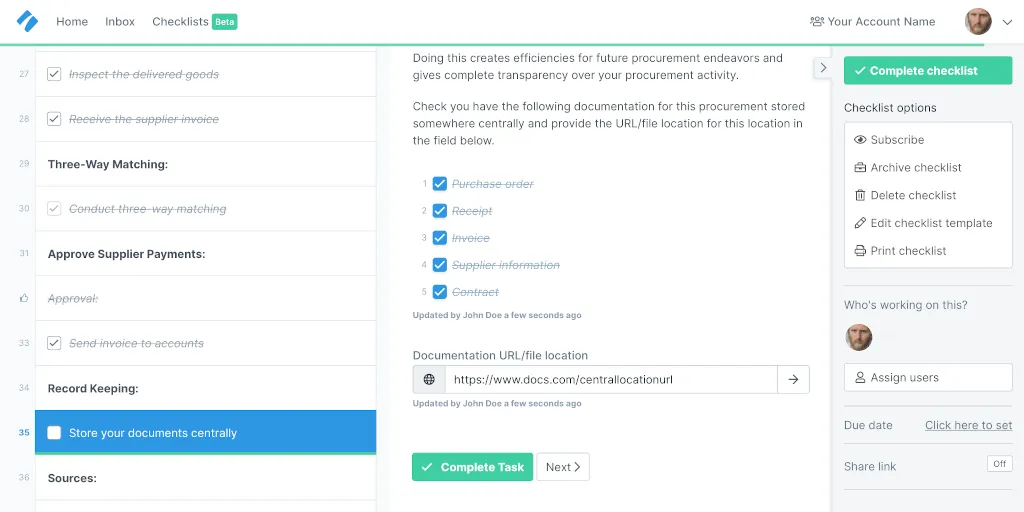
That’s the procurement process flow!
All in all, it’s a massively useful (and not to mention easy) procurement flow built for everyday usage. Even when there are disruptions – let’s say a supplier goes out of business, or another supplier can’t provide you the goods and/or services for when you need them – it’s simple to return to this checklist template and source a new supplier to work with.
Hopefully, by now, you realize that Process Street is a necessary tool for the procurement process. But it’s necessary for all the rest of your business’ processes, as well.
Use Process Street for procurement and all other business needs!
Process Street is superpowered checklists.
If you document workflows, business processes, and integral procedures as templates, you can then launch an infinite number of checklists from those templates. The checklists will help ensure you and your team complete tasks to the high-standards your business wants.
For a glimpse into how other businesses are utilizing Process Street for their processes, check out how TechMD does it.
Now, in terms of the procurement process, you can go ahead and use the template I went over in the section above. Or, you can create processes from scratch after signing up for a free trial!
Similarly, you can make use of our other pre-made business process templates related to purchasing, procurement, and the supply chain, or make your own versions.
For instance, here are several procurement-related process templates that’ll bolster how your business goes about procurement:
This Purchase Order Workflow Template makes managing your purchase order workflow incredibly easy. You can seamlessly track progress in real-time and shorten purchasing cycles.
Click here to get the Purchase Order Workflow Template!
This Accounts Payable Process will help you provide checks and balances for all outgoing payments to suppliers for their goods or services. A definite checklist template to add to your account, if I do say so myself.
Click here to get the Accounts Payable Process!
And let’s say you’re wanting to optimize the procurement process further. That’s easily done, thanks to The Process for Optimizing a Process.
Click here to get The Process for Optimizing a Process!
All these checklist templates have been superpowered due to Process Street’s workflow automation features.
These include (but aren’t limited to):
- Stop tasks

- Conditional logic

- Dynamic due dates

- Task permissions

- Task assignments

- Role assignments

- Webhooks

- Embed widget

- Approvals

- And many, many more!

To deep dive into some of these features, watch the following webinar.
Additional resources for purchasing, procurement, and processes
Before you go, you may want to read some additional, helpful material on purchasing, procurement, and processes.
The following blog posts, diligently written by Process Street’s content team, have you covered:
- Getting Started with Process Street
- What is Business Process Management? A Really Simple Introduction
- What is BPM? The Ultimate Guide to Getting Started
- Best Process Documentation Software Compared: Office 365 vs Process Street
- Implementing Processes: How to Boost Success Rate by 70%
- How TechMD Use Process Street to Manage All Their Recurring Processes
- How to Write Process Documentation That Helps Your Business Scale (in 5 Steps)
- Business Process Optimization: How to Improve Workflows Like a Pro (Free Templates!)
- How to Build a Better Purchase Order Workflow with Process Street
- What is a Purchase Order Template? 5 Free Templates to Get Started
- Purchase Requisition: How to Get Finance to Buy You New Software
- Digital Procurement: How to Cut Costs Without Losing Profitability
- Vendor Management: What It Is and How to Excel at It (Free Templates)
- 8 Logistics Management Processes to Perfect Your Supply Chain
- How to Support €38.8 Billion Revenue: Tips from IKEA’s Supply Chain
There you have it.
With the information supplied in this post, the nifty checklist templates for your processes, and a shiny Process Street account, you’re one step close to becoming a pro at procurement.
Do you take part in procurement activities for your business? If so, are there any tips and tricks you’d like to share with the rest of the Process Street community? Write them in the comment section below! 
